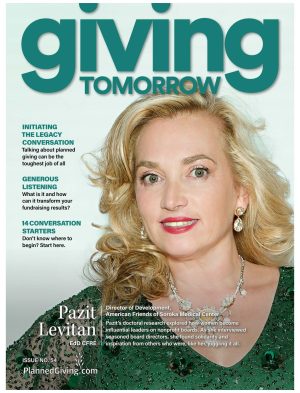Question
In your Strange Myths section in Giving Tomorrow Magazine, the statement is made that “Most planned giving donors are not prospects for large major gifts.”
Did the word “not” creep in there by mistake?
Answer
This is a really good question and common misperception.
Over the last several years there have been a number of studies of the most likely planned giving prospects. We have learned that those individuals who are loyal to your organization and mission are the most likely to be open to the planned giving message. Typically we measure loyalty by regular, consistent annual giving. One of the studies showed that donors who give 15 or more times are the best planned giving prospects. It does not matter the amount they give, just that they give. So wealth is not a factor in determining your planned giving prospects. In fact, when you do a wealth screening and overlay it on a loyalty screening, for most charities more than 90% of their loyal donors, those most open the planned giving message, are not on the wealth screening because they are not major or principal gift prospects. So when you put together your prospect list for planned giving, look at loyalty, and not wealth.
This is not to say that wealth doesn’t matter at all. Once you have your loyal donors identified, it is perfectly OK to segment by wealth for the purposes of your gift planning marketing. For example, I would never market “maximizing your children’s and grandchildren’s inheritance while supporting our mission” to donors who have very limited capacity. They are not thinking about the inheritance they are leaving behind. But I might market a message of “increase your income in retirement” or “make a gift that doesn’t cost you anything today” to this audience. Another segment to consider are those with no children. Among your loyals, they are most likely to actually complete a planned gift. But if they have no loyalty, then they are not a target audience. The key is to identify the loyals first, then segment based on your message or who you want to reach. I detail how to select your audience in my book, The Philanthropic Planning Companion, which is available at PlannedGiving.Com. If you want more help to select the right gift planning audience, it can be found in Module III of Planned Giving in a Box at PlannedGivinginabox.Com, with all the steps and materials required to build an effective planned giving program.
Besides writing this column and consulting for PlannedGiving.com, Brian Sagrestano is President and CEO of Gift Planning Development, LLC, and a principal in Constellation Advancement, LLC. He co-authored The Philanthropic Planning Companion, which has everything a gift planning officer needs to know. Here you’ve got a direct pipeline to the author. Ask Brian your questions at PlannedGiving.com/Brian.




